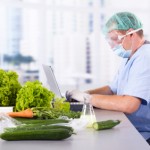On June 7th CDC officials were quoted as saying an unusual strain of E. coli, similar to that that has caused the on-going epidemic in Germany, had also, in the US in 2010, caused even more illness than the more common form of the bacteria. In this country, however, the national tracking and monitoring system for food-bourne diseases, revealed considerably less serious problems, with fewer of those affected requiring hospitalization.
So what actually happened here vs. in Europe? Let's start with what E. coli is and how we determine its variants (or strains as they are usually termed). In 1885 a German physician/bacteriologist discovered the most common bowel bacterium. His name was Theodor Escherich and the organism was found in the colon, so its name became Escherichia coli, E. coli for short. Several types of E. coli are part of the normal flora of the human gut, are not a threat to our health, help keep more dangerous bacteria from colonizing the bowel and can actually produce, in some instances, forms of vitamin K.
Laboratories test for E. coli strains by determining which form of the bacterium's antigens are found in its various structural components layer. The ones that form the major surface antigens are the O antigens, and the H and K antigens. The O157:H7 variety is more virulent than most others and causes diarrheal disease by producing a toxin harmful to the lining of the intestine.
Even that nasty "bug," which can be found in undercooked beef, but also other foods, is not lethal to most affected by it. Most healthy adults recover from a O157:H7 infection in 5 to 7 days. Roughly 6% of those affected, usually young children, elderly adults and people of all ages with weakened immune systems, can develop much more serious complications such as hemolytic uremic syndrome (HUS) in which red blood cells break down (hemolysis), blood platelets (responsible for clotting) clump up in small blood vessels in the kidneys and acute kidney failure occurs.
The most common problem bacterium, E. coli O157:H7, has for some time been a focal point for eradication from food products. The others, commonly called the "non-O157s" haven't routinely been tested for. Now the debate is whether US meat packers will be forced to check for rarer forms of E. coli making the selling of ground beef that contains it illegal.
Why is ground beef the focus?
It often contains meat from a number of cows (sometimes a large number) and has to be thoroughly cooked to break down the toxin. The day of the safe rare hamburger (I used to love them) may well be over. Other cuts of beef would come from just one animal and cooking the surface is usually felt to be relatively safe.
Meanwhile in Europe the number affected by the epidemic is up to almost 3,000 in 12 countries with over 700 developing HUS and 30 deaths. The lab tests on sprout samples were negative, but people who ate bean sprouts were nine times more likely to become infected than those who hadn't.

